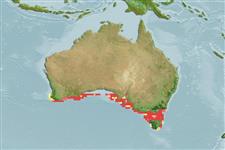Actinopterygii (ray-finned fishes) >
Gasterosteiformes (Sticklebacks and seamoths) >
Pegasidae (Seamoths)
Etymology: Pegasus: Taken form the winged horse of Perseus in the ancient Greek, mithology (Ref. 45335); lancifer: From the Latin word 'lancea' meaning a light spear or lance.. More on author: Kaup.
Environment / Climate / Range
Ecology
Marine; brackish; demersal; depth range 20 - 60 m. Temperate, preferred ?; 33°S - 45°S
Eastern Indian Ocean: endemic to the temperate waters of southern Australia and Tasmania.
Size / Weight / Age
Maturity: Lm ? range ? - ? cm
Max length : 9.1 cm SL male/unsexed; (Ref. 1418)
Short description
Morphology | Morphometrics
Dorsal
spines
(total): 0;
Dorsal
soft rays
(total): 5;
Anal
spines: 0;
Anal
soft rays: 5;
Vertebrae: 22. Body light to dark brown, olive or blue dorsally and laterally, light brown ventrally. Tail rings 14, anteriormost 7 mobile, remaining 7 fused; terminal tail rings with dorsal and ventral pairs of posteriorly directed spines; rostrum square in cross section; interpectoral plate absent. 4 pairs dorsolateral body plates; 5 pairs ventrolateral body plates; suborbital shelf convex, obscuring eye from ventral view; deep pits on dorsal surface of head and within interorbital depression absent. Orbit with small scales.
Large numbers of individuals are known to congregate in the shallows of estuaries. The species is capable of burying itself in the sediment and change colors to match the background.
Life cycle and mating behavior
Maturity | Reproduction | Spawning | Eggs | Fecundity | Larvae
Spawning occurs as male & female swim from vent to vent, about 1 meter off the bottom, while they release eggs & sperms. The pair separates and each swims away as the eggs begin a pelagic phase.
Palsson, W.A. and T.W. Pietsch, 1989. Revision of the Acanthopterygian fish Family Pegasidae (Order Gasterosteiformes). Indo-Pac. Fish. (18):38 p. (Ref. 1418)
IUCN Red List Status (Ref. 115185)
CITES (Ref. 94142)
Not Evaluated
Threat to humans
Harmless
Human uses
More information
Age/SizeGrowthLength-weightLength-lengthLength-frequenciesMorphometricsMorphologyLarvaeLarval dynamicsRecruitmentAbundance
ReferencesAquacultureAquaculture profileStrainsGeneticsAllele frequenciesHeritabilityDiseasesProcessingMass conversion
Tools
Special reports
Download XML
Internet sources
